Nanoencapsulation of Lutein with Hydroxypropylmethyl Cellulose Phthalate by Supercritical Antisolvent*
2009-05-15JINHeyang金鹤阳XIAFei夏菲JIANGCuilan江翠兰ZHAOYaping赵亚平andHELin何琳
JIN Heyang (金鹤阳), XIA Fei (夏菲), JIANG Cuilan (江翠兰), ZHAO Yaping (赵亚平),** and HE Lin (何琳)
Nanoencapsulation of Lutein with Hydroxypropylmethyl Cellulose Phthalate by Supercritical Antisolvent*
JIN Heyang (金鹤阳)1, XIA Fei (夏菲)1, JIANG Cuilan (江翠兰)1, ZHAO Yaping (赵亚平)1,**and HE Lin (何琳)2
1School of Chemistry and Chemical Engineering, Shanghai Jiao Tong University, Shanghai 200240, China2Analysis Center of Shanghai Jiao Tong University, Shanghai 200240, China

nanocapsule, lutein, hydroxypropylmethyl cellulose phthalate, supercritical antisolvent precipitation
1 INTRODUCTION
Lutein, as a kind of natural pigment widely existed in fruits, vegetables, flowers and some algaes [1], has been applied as a food additive for several years. It is popular in the market for preventing aging, protecting eyes, anti-oxidation, counter-heart disease and anti-cancer, especially as a valuable functional food ingredient [1-7]. Lutein is a derivative of α-carotene with the molecular formula of C40H56O2and its molecular structure is shown in Fig. 1.

Figure 1 The molecular structure of lutein
Due to the thermal and optical instability [8], the application of lutein in food is limited. Therefore, it is necessary to find a method to avoid these disadvantages. The encapsulation technique can protect food ingredients against deterioration and volatile losses, prevent the interaction between ingredients, maintain the inherent flavor and insulate some unfavorable smell. Some conventional methods, such as Wurster method, milling, spray-drying, and emulsion freeze drying, have been used in encapsulation techniques [9-11]. However, the applications in food and pharmaceutical industry is restricted by excessive use of organic solvent, high residual content of toxic solvent and other disadvantages. For example, the excess of organic solvent and high temperature in spray drying process are adverse to thermal stability and bioactivity of ingredients.
Using supercritical CO2to encapsulate bioactive substances is a newly developed method and has been widely used because of low critical temperature and no toxicity. Some methods, such as the rapid expansion from supercritical solution (RESS), gas antisolvent(GAS), supercritical antisolvent precipitation (SAS), aerosol solvent extraction (ASES) and precipitation with a compressed fluid antisolvent (PCA), have been utilized in recent years [12-15]. Among these methods, the supercritical antisolvent (SAS), with its more feasible applications, has been given more attention [16, 17]. The protein (insulin)-loaded polymeric (PLA) microcapsules were prepared by SAS, with the average diameter of capsules in the range of 0.5-2 μm [18].
To our knowledge, little has been reported on the nanoencapsulation of lutein with SAS. In this work, the objective is to make the nanoencapsulation of lutein by using SAS for the lutein to be used as a functional (healthy) food ingredient more conveniently. The effects of processing variables on the yield, lutein loading and efficiency of nanocapsules are studied. The morphology, the size and the content of lutein are characterized by SEM, particle size analyzer and UV spectrum, respectively. Hydroxypropylmethyl cellulose phthalate (HPMCP), widely used as an innoxious auxiliary material in the pharmacy, is selected as the coating material due to its gastric juice resistance.
2 MATERIALS AND METHOD
2.1 Materials
Lutein was made in our laboratory with the purity of 92% analyzed with HPLC. HPMCP (HP55) was supplied by Hopetop Ltd. (Jiangsu, China). Acetone (AR) was purchased from Shanghai Linfeng Chemical Reagents Ltd. (Shanghai, China). CO2with the purity of 99.95% was obtained from SJTU Gas Station (Shanghai, China).
2.2 Experimental method
2.2.1

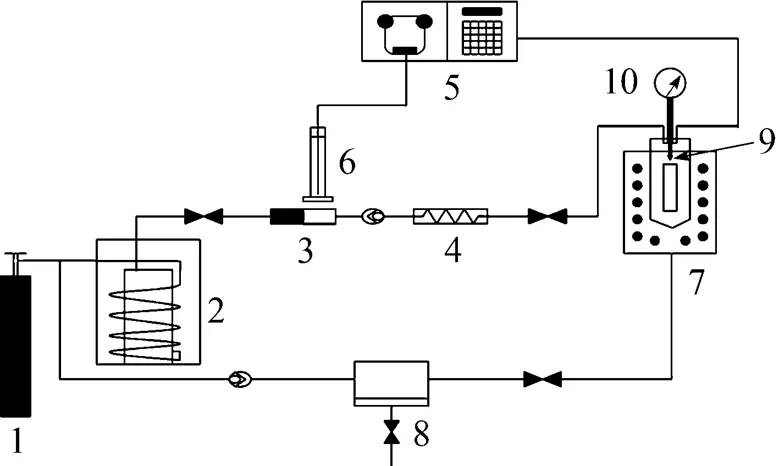
Figure 2 Scheme of the apparatus for SAS experiment 1—CO2cylinder; 2—cooling system (refrigerator); 3—piston pump; 4—heat exchanger; 5—HPLC pump; 6—solution; 7—vessel (precipitator); 8—separator; 9—nozzle; 10—pressure meter

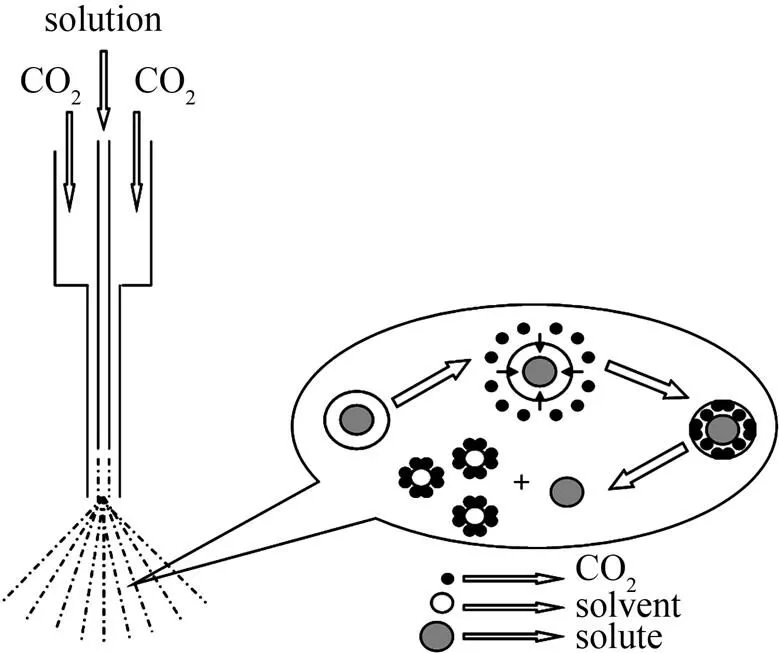
Figure 3 Structure of the nuzzle and illustration for formation of nanocapsules
2.2.2
Lutein may exist in the nanospheres in two forms, adsorbed on the surface and embedded in the nanospheres, called nanocapsules. The encapsulation efficiency (EE) is defined as the ratio of the mass embedded to total amount of lutein in the product,

The measurement is as follows. 10 mg of nanocapsules was dissolved in acetone to form a homogeneous solution, and UV spectrophotometry was used to determine the content of lutein,l. Another 10 mg of nanocapsules was in excessive hexane for several minutes so that the lutein adsorbed on the surface was dissolved in hexane, and then the contentswas determined.
2.2.3
The yield of product was the ratio between the final mass of nanocapsules obtained and the initial mass of raw material injected into the precipitator.
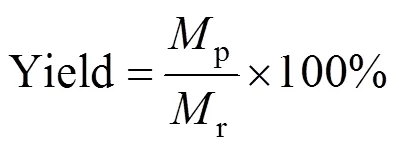
2.2.4
The lutein loading (LL) was the content of lutein in the final product. The measurement is similar to that in Section 2.2.2.

2.2.5
Scanning electron microscope (SEM) was applied to observe the morphology of HPMCP/lutein nanocapsules. A small amount of HPMCP/lutein nanocapsules were placed on one surface of a double-faced adhesive tape stuck to the sample stage, then coated with gold under vacuum condition to enhance their electric ability and observed on a JOEL (JEM-7401F) scanning electron microscope. The photos were obtained at a magnification of 30000 and 60000.
2.2.6
The particle size (PS) and particle size distribution (PSD) of HPMCP/lutein nanocapsules were determined by a particle size analyzer (ZETA SIZER, nano series, Malvern). A small amount of nanocapsules were put into pure water and dispersed by ultrasonic. The sample was placed in the analyzer and suitable refractive index was chosen to scan. The temperature was 25°C, the duration was 70 s and the count rate was 115 kilocycles per second. The mean diameter (m) and PSD of the sample were recorded.
3 RESULTS AND DISCUSSION
3.1 Effects of pressure and temperature
Some physical properties of supercritical CO2, such as density, viscosity, diffusivity and surface tension , depend on pressure and temperature, and will affect the product in the SAS process.
According to the experiments Nos. 1, 2 and 3 in Table 1, the yield of product increases with pressure. Lutein will reach higher supersaturation because its solubility in acetone is decreased at higher pressure, so that more lutein is deposited. On the contrary, lutein loading and encapsulation efficiency decrease as the pressure increases. The PSD of the product in Nos. 2 and 3 are shown in Fig. 4. At 40°C, the mean diameter of nanocapsules is increased from 171 nm at 13 MPa to 314 nm at 15 MPa, and the PSD is broadened from 90-310 nm to 180-640 nm correspondingly. In addition, the value of polydispersity index (PDI) reflects the uniformity of nanoparticles. The lower the PDI value, the more uniform of the particles. It is possible for the HPMCP to be expanded a little at high pressure of SC-CO2because it is a polymer.
The experiments Nos. 1, 4 and 5 in Table 1 show that the yield has a maximum value as the temperature increases. In this ternary system, higher temperature enhances the transfer and dissolution of SC-CO2in acetone, and more lutein will be precipitated. However, higher temperature may increase the solubilities of HPMCP and lutein in the original solution and reduce the mutual solvation of SC-CO2and the solvent, so that less HPMCP and lutein are deposited. Another possible reason for the low loading of lutein is that lutein may degrade at higher temperature [19]. Therefore, the yield depends on different effects of temperature. Similarly, lutein loading and encapsulation efficiency have the minimum values accordingly. The mean diameter of product also has a maximum value in the temperature range. Since the temperature influences the infiltration of CO2into HPMCP, its effect on the particle size of product is irregular.
An important objective of this work is to control the size of HPMCP/lutein capsules in nano-scale. It was reported that nanoparticles could be produced when the operating pressure was well above the mixture critical point (MCP) [20]. In this study, the operating temperature and pressure were controlled above the MCP of CO2-acetone binary system with 0.98 mole fraction of CO2(the data was evaluated according to Refs. [21, 22]). In experiments Nos. 1-5, when the temperature and pressure were equal to or above 40°C and 11 MPa, respectively, we obtained the nanocapsules with the mean diameter (m) ranging from 163 nm to 314 nm.
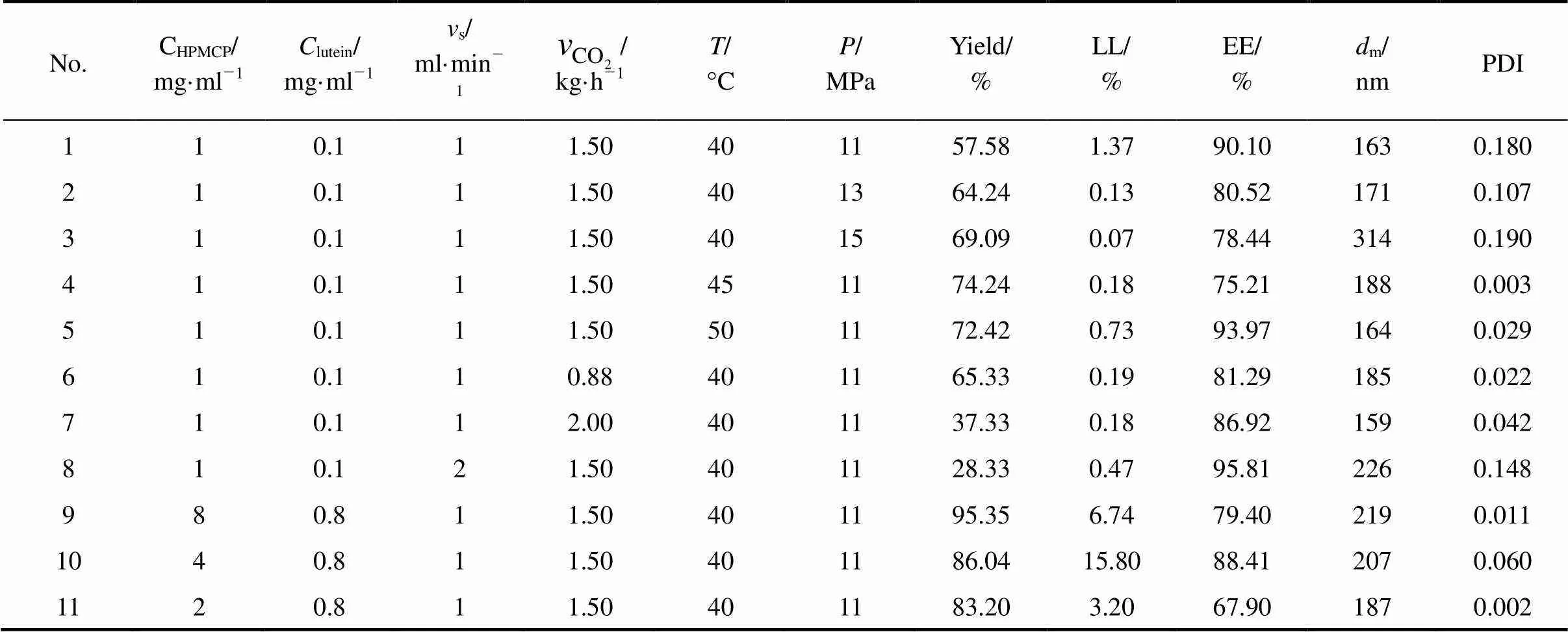
Table 1 Experimental conditions and results
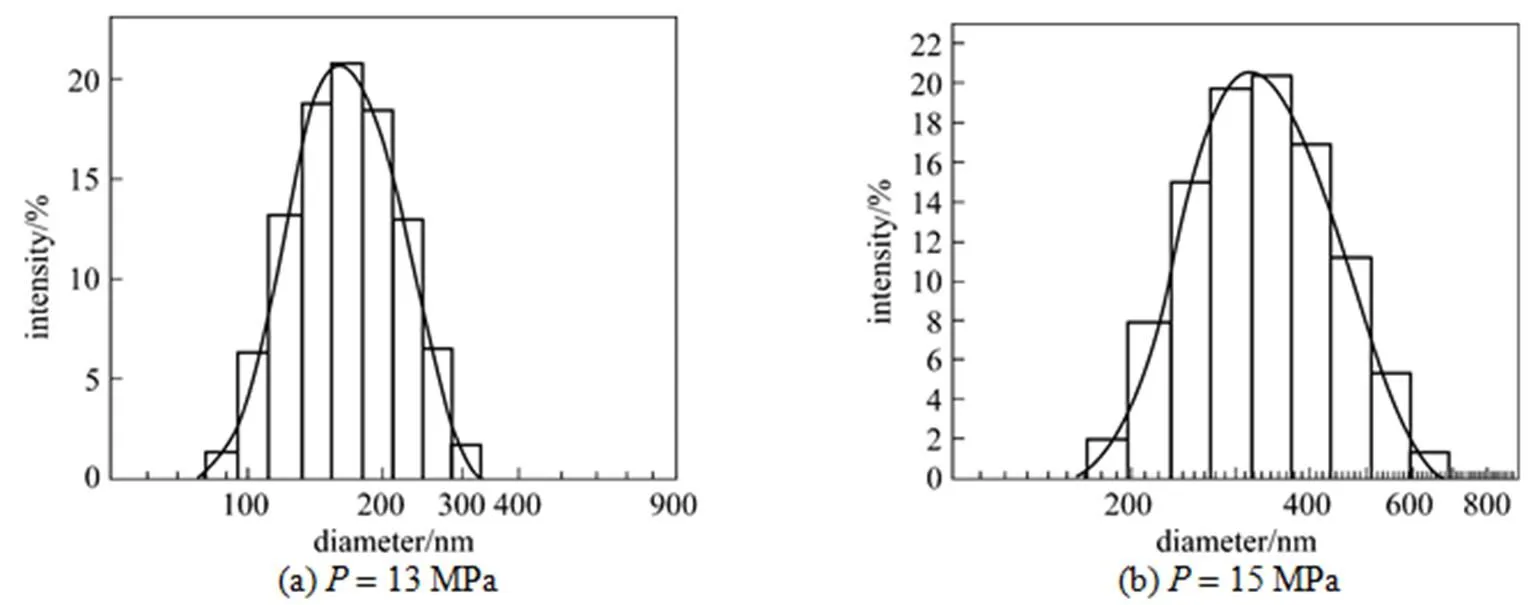

3.2 Effects of flow rate of CO2
The flow rate of CO2influences the mass transfer between the solvent and CO2and change the supersaturation of the solute. Higher rate usually favors the product yield, but if it is too high, the result will be opposite. As shown by Nos. 1, 6 and 7 in Table 1, the yield decreases when the flow rate of CO2is increased. The reason may be that high flow rate of SC-CO2carries the solution out from the precipitation vessel. Similarly, the lutein loading and encapsulation efficiency are not high, as shown in Table 1. When the flow rate of solution is increased from 1 ml·min-1(No. 1) to 2 ml·min-1(No. 8), the yield decreases from 57.6% to 28.3%, and the lutein loading decreases from 1.37% to 0.47%, due to the loss of HPMCP and lutein.
The flow rate of CO2also influences the PS. As shown by Nos. 5-7 in Table 1, the PS decreases a little as the flow rate of SC-CO2increases. The reason may be that high flow rate results in higher supersaturation. Thus it is necessary to choose suitable flow rate of SC-CO2in SAS. The ratio between the flow rates of CO2and solution is also a key factor in the process.
3.3 Effects of concentration and the ratio of HPMCP/lutein
In Table 1, the yield and lutein loading of No. 1 are lower than those of No. 9. Higher concentration of HPMCP leads to higher supersaturation of solution and then more solute precipitate. However, the encapsulation efficiency of No. 1 is higher than that of No. 9. The possible reason is that most of lutein on the surface of the nano-spheres is taken away by the solvent in No. 1 experiment, while in No. 9, a lot of lutein is left on the surface due to its large quantity. The particle size of No. 9 is larger than that of No. 1. The similar trend was reported in Ref. [20]. Therefore, the concentration of solute is an important factor for the recovery rate.
According to the data of Nos. 9-11 in Table 1, the effect of the ratio between HPMCP and lutein in acetone is studied. By increasing the ratio from 2.5︰1 to 10︰1, the yield increases from 83.20% to 95.35%. In No. 9, HPMCP and lutein are in their saturated concentrations at room temperature, so that the highest yield, 95.35%, is obtained. In addition, the mean diameter of capsules increases about 50 nm and the PSD becomes wider, as shown in Fig. 5 (a). The reduction of the ratio between coating material and the core usually increase the lutein loading. It is true for experiments Nos. 9 and 10. However, if the ratio is too low, the result is opposite. In No. 11, the lutein loading is the lowest among the experiments Nos. 9-11. The possible reason is that most of lutein is taken away by SC-CO2. Therefore, the lutein loading does not always increase as the amount of HPMCP decreases. For the encapsulation efficiency, the trend is similar. Thus the ratio between HPMCP and lutein plays an important role. As shown by the PS data of Nos. 9-11 and Fig. 6, the particle size of the product becomes smaller and the PSD becomes narrower as the ratio decreases, in which the concentration of HPMCP decreases from 8 to 2 mg·ml-1. The result is also consistent with a previous report [20]. The image of SEM reveals that the particles are nearly spherical, as shown in Fig. 5. The PSD is also well-proportioned as shown in Fig. 6.
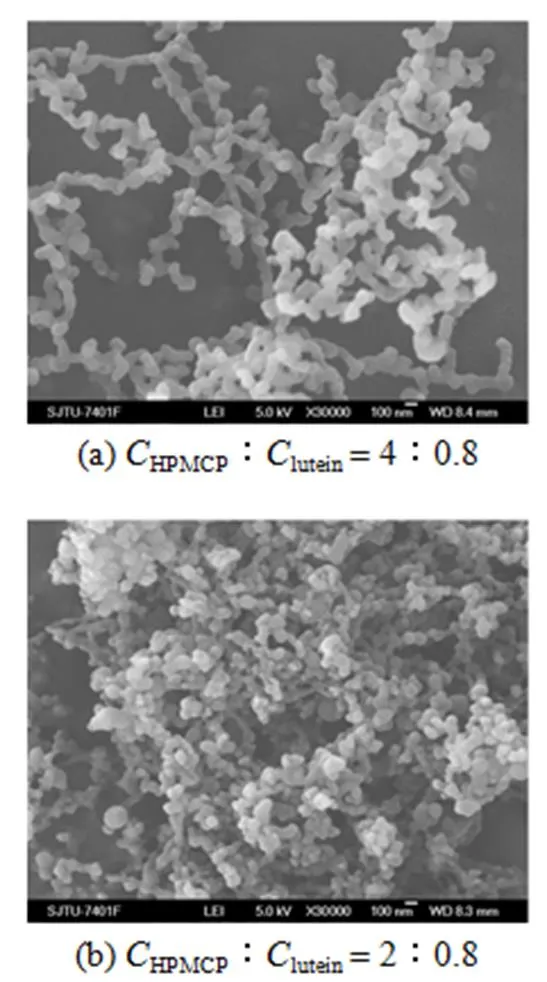

4 CONCLUSIONS
HPMCP/lutein nanocapsules were produced using a supercritical antisolvent process. The highest yield was obtained when the initial concentrations of HPMCP and lutein were saturated, respectively. Moreover,the optimal condition for the highest lutein loading and encapsulation efficiency is 11 MPa, 40°C and the ratio of 4 mg·ml-1︰0.8 mg·ml-1ofHPMCP︰lutein. The mean diameter of the nanocapsules, being nearly spherical, was in the range of 163-219 nm. This work would promote the application of lutein in food and pharmacy industry.


NOMENCLATURE
HPMCPentration of HPMCP, mg·ml-1
luteinconcentration of lutein, mg·ml-1
mmean diameter of capsules, nm
EE encapsulation efficiency, %
LL lutein loading, %
lmass of lutein in the product, mg
pmass of product, mg
rmass of raw material, mg
smass of lutein on the surface of product, mg
pressure, MPa
PDI polydispersity index
PS particle size, nm
PSD particle size distribution
temperature,°C
svolumetric flow rate of solution, ml·min-1
1 Landrum, J.T., Bone, R.A., Joa, H., Kilburn, M.D., Moore, L.L., Sprague, K.E., “A one year study of the macular pigment: the effect of 140 days of a lutein supplement”,, 65, 57-62 (1997).
2 Gaziano, J.M., Manson, J.E., Ridker, P.M., “Beta carotene therapy for chronic stable angina”,, 82, 796 (1990).
3 Cutler, R.G., “Carotenoids and retinol: their possible importance in determining longevity of primate species”,...., 87, 7627-7631 (1984).
4 Hammond, B.R., Wooten, B.R., Snodderly, D.M., “Density of the human crystalline lens is related to the macular pigment carotenoids, lutein and zeaxanthin”,..., 77, 499-504 (1997).
5 Mortensen, A., Skibsted, L.H., Sampson, J., Rice-Evans, C., Everett, S.A., “Comparative mechanisms and rates of free radical scavenging by caretenoid antioxidants”,, 418, 91-97 (1997).
6 Kozuki., Y., Miura, Y., Yagasaki, K., “Inhibitory effects of carotenoids on the invasion of rat ascites hepatoma cells in culture”,, 151, 111-115 (2001).
7 Narisawa, T., Fukaura, Y., Hasebe, M., “Inhibitory effects of natural carotenoids, alpha-carotene, beta-carotene, lycopene and lutein, on colonic aberrant crypt foci formation in rats”,, 107, 137 (1996).
8 Subagio, A., Wakaki, H., Morita, N., “Stability of lutein and its myristate esters”,..., 63, 1784-1786(1999).
9 Arimoto, M., Ichikawa, H., Fukumori, Y., “Microencapsulation of water-soluble macromolecules with acrylic terpolymers by the Wurster coating process for colon-specific drug delivery”,, 141, 177-186 (2004).
10 Shu, B., Yu, W.L., Zhao, Y.P., Liu, X.Y., “Study on microencapsulation of lycopene by spray-drying”,, 76, 664-669 (2006).
11 Breitkreutz, J., El-Saleh, F., Kiera, C., Kleinebudde, P., Wiedey, W., “Paediatric drug formulations of sodium benzoate (II) Coated granules with a lipophilic binder”,...., 56, 255-260 (2003).
12 Matson, D.W., Fulton, J.L., Peterson, R.C., “Rapid expansion of supercritical fluid solutions: Solute formation of powders, thin films, and fibers”,...., 26, 2298 (1987).
13 Dixon, D.J., Johnston, K.P., “Formation of microporous polymer fibers and oriented fibrils by precipitation with a compressed fluid antisolvent”,...., 50, 1929 (1993).
14 Bleich, J., Kleinebudde, P., Mueller, B.W., “Influence of gas density and pressure on microparticles produced with the ASES process”,..., 106, 77 (1994).
15 Liu, X.W., Li, Z.Y., Han, B., Yuan, T.L., “Supercritical antisolvent precipitation of microparticles of quercetin”,...., 13, 128-130 (2005).
16 Falk, R., Randolph, T., Meyer, J.D., Kelly, R.M., Manning, M.C., “Controlled release of ionic compounds from poly (L-lactide) microspheres produced by precipitation with a compressed antisolvent”,., 44, 77 (1997).
17 Mawson, S., Kanakia, S., Johnston, K.P., “Coaxial nozzle for control of particle morphology in precipitation with a compressed fluid antisolvent”,...., 64, 2105 (1997).
18 Elvassore, N., Bertucco, A., “Production of proteinloaded polymeric microcapsules by compressed CO2in a mixed solvent”,...., 40, 795-800 (2001).
19 Naranjo-Modad, S., López-Munguía, A., Vilarem, G., Gaset, A., Bárzana, E., “Solubility of purified lutein diesters obtained fromin supercritical CO2and the effect of solvent modifiers”,..., 48, 5640-5642 (2000).
20 Reverchon, E., Marco, I.D., Torino, E., “Nanoparticles production by supercritical antisolvent precipitation: A general interpretation”,.., 43, 126-136 (2007).
21 Chen, J.W., Wu, W.Z., Han, B.X., “Phase behavior, densities, and isothermal compressibility of CO2+pentane and CO2+acetone systems in various phase regions”,..., 48, 1544-1548 (2003).
22 Wu, W.Z., Ke, J., Poliakoff, M., “Phase boundaries of CO2+toluene, CO2+acetone, and CO2+ethanol at high temperatures and high pressures”,...., 51, 1398-1403 (2006).
2008-12-02,
2009-03-28.
the National High Technology Research and Development Program of China (2007AA10Z350).
** To whom correspondence should be addressed. E-mail: ypzhao@sjtu.edu.cn
猜你喜欢
杂志排行
Chinese Journal of Chemical Engineering的其它文章
- Removal of Uranium (VI) by Fixed Bed Ion-exchange Column Using Natural Zeolite Coated with Manganese Oxide*
- Phase Equilibrium of Isobutanol in Supercritical CO2
- Conversion of Methane by Steam Reforming Using Dielectric-barrier Discharge*
- Permeability and Selectivity of Sulfur Dioxide and Carbon Dioxide in Supported Ionic Liquid Membranes*
- Hydroxyapatite Coatings on Titanium Prepared by Electrodeposition in a Modified Simulated Body Fluid*
- Model Study on a Submerged Catalysis/Membrane Filtration System for Phenol Hydroxylation Catalyzed by TS-1*
